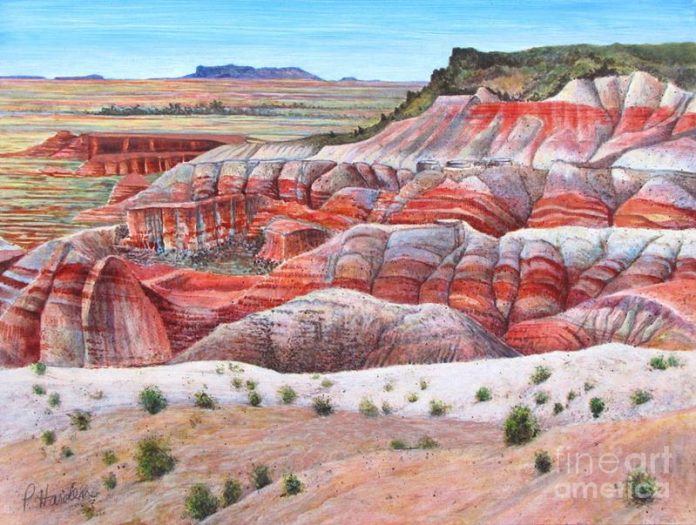
The Painted Desert was once described by a geologist as a “sedimentary circus.” The brilliant colors and bizarre patterns found throughout this 140-mile-long tract of badland topography in northeastern Arizona are somewhat reminiscent of colorful circus costumes.
Geologically, the Painted Desert is an expanse of heavily eroded, sedimentary formations with exposed, colorful strata of siltstone, mudstone, and shale interspersed with thin layers of limestone and volcanic material. Sparsely vegetated and arid, this region would have attracted little attention had it not been for its remarkable colors.
Visual artists have long been drawn to, and intrigued by, the Painted Desert’s surreal colors and patterns. But while artists work from palettes with a wide array of oil, acrylic, and watercolor paints in every conceivable hue, the mineralogical palette that created the Painted Desert’s natural colors has only a handful of minerals.
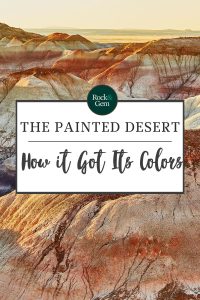
“Colorful and Strange Scenery”
When Spanish explorer Francisco Vázquez de Coronado ventured into the American Southwest in 1540, members of his scouting party became the first Europeans to see the Grand Canyon. To reach the canyon, they traversed an expanse of flat-topped mesas, sculpted buttes, and deeply eroded gullies. Awed by its kaleidoscopic colors, they named the region El Desierto Pintado—the Painted Desert.
In 1858, John Strong Newberry, a geologist with a U. S. Army exploratory expedition, made the first documented use of the English term “Painted Desert” when he described in detail the region’s “colorful and strange scenery.”
It was initially thought a different mineral caused each of the Painted Desert’s colors—blacks, grays, and off-whites to reds, pinks, yellows, greens, blues, purples, and browns. By the late 1800s, geologists had learned that the myriad colors of these 210-million-year-old Triassic sediments were created by only a few minerals.
Reds, Yellows, and Brown
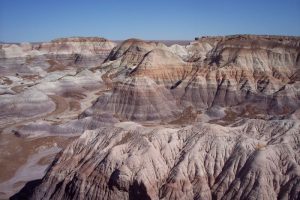
Courtesy Wikimedia Commons
The Painted Desert’s dominant color is red. Regardless of whether a particular reddish stratum is a delicate pink or a deep, rich burgundy, its color is due to particulate hematite or iron oxide—the same mineral that colors the red rocks of Utah and the red clay of Georgia. The broad range of reddish hues reflects varying concentrations of hematite combined with several other complementary mineral pigments.
Iron, in the form of goethite, or basic iron oxide, produces the Painted Desert’s yellows and browns. Iron deposited in oxidizing environments above the water table formed as hematite; below the water table, it formed as goethite and other hydrated iron oxides.
The Whites
Particularly eye-catching are strata where intensely colored, red layers of mudstone make sharp contact with strata of bright, white mudstone. Initially, many Painted Desert white strata were red, due to hematite coatings on quartz sand grains. But with wide variations in permeability, some strata trapped groundwater which sometimes became acidic, triggering a bleaching process that dissolved the hematite coatings to leave behind pure quartz grains that transformed the mudstone from red to white.
Some of the Painted Desert’s white coloration is due to concentrations of white or colorless gypsum, a hydrous calcium sulfate. Other white coloration is due to concentrations of bentonite, a white, montmorillonite clay that forms through alteration of volcanic-ash layers. Because it expands when wet, then contracts as it dries, bentonite contributes to severe soil instability, explaining both the Painted Desert’s vulnerability to rapid erosion and its sparse vegetation.
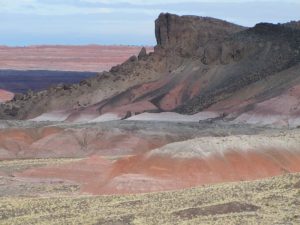
Courtesy Wikimedia Commons
Greens, Purples, and Black
Green strata often indicate concentrations of glauconite, the term for a subgroup of mica minerals. Glauconite forms from slow, sedimentary deposition in shallow, marine environments that are favorable for chemical reduction. Translucent to opaque, glauconite minerals occur as sand grains with colors ranging from yellowish-green to bluish-green. Concentrations form compact, clay-like layers with saturated, greenish colors.
Purple, lavender, and blue coloration is usually due to concentrations of pyrolusite and other closely related manganese oxides. Some black or dark strata are concentrations of organic matter that has been chemically reduced to particles of elemental carbon. Geologically recent volcanic flows have occasionally emplaced thin layers of igneous rocks, usually dark basalt, that strikingly accent the lighter colors of adjacent sedimentary strata.
Combinations of color-causing minerals along with varying degrees of chemical bleaching produce a continuous spectral gradient. An example is strata containing both hematite and pyrolusite can be a rich mahogany brown, while partially bleached, hematite-rich strata are a delicate pink.
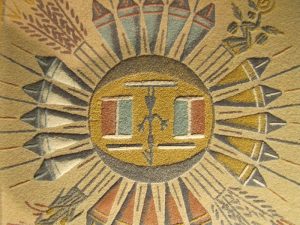
Courtesy Steve Voynick
Sand Paintings and Petrified Wood
The ready availability of the Painted Desert’s varicolored sands may have partly inspired the art of Navajo sand painting. Sand paintings, also called “dry paintings,” are symbolic representations of Navajo mythology that are used in sacred healing ceremonies. They consist of colored sands skillfully placed to form designs. More than a century ago, the first media for these paintings were likely colored sands derived from selected strata of the Painted Desert.
The most accessible section of the Painted Desert sprawls across the northern part of Petrified Forest National Park along Interstate 40 east of Holbrook, Arizona. The visitor center displays large, polished slabs of petrified wood; the bright multi-coloration of these slabs closely matches that of the Painted Desert itself, justifying their description as “the Painted Desert in stone.”
It is interesting to consider that, while artists draw upon a complex palette of paints of every hue to capture the Painted Desert’s splendor, nature created this “sedimentary circus” using a palette of only a handful of minerals.
This story about the Painted Desert appeared in Rock & Gem magazine. Click here to subscribe. Story by Steve Voynick.













